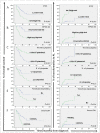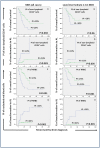The proliferation index of specific bone marrow cell compartments from myelodysplastic syndromes is associated with the diagnostic and patient outcome
- PMID: 22952954
- PMCID: PMC3432128
- DOI: 10.1371/journal.pone.0044321
The proliferation index of specific bone marrow cell compartments from myelodysplastic syndromes is associated with the diagnostic and patient outcome
Abstract
Myelodysplastic syndromes (MDS) are clonal stem cell disorders which frequently show a hypercellular dysplastic bone marrow (BM) associated with inefficient hematopoiesis and peripheral cytopenias due to increased apoptosis and maturation blockades. Currently, little is known about the role of cell proliferation in compensating for the BM failure syndrome and in determining patient outcome. Here, we analyzed the proliferation index (PI) of different compartments of BM hematopoietic cells in 106 MDS patients compared to both normal/reactive BM (n = 94) and acute myeloid leukemia (AML; n = 30 cases) using multiparameter flow cytometry. Our results show abnormally increased overall BM proliferation profiles in MDS which significantly differ between early/low-risk and advanced/high-risk cases. Early/low-risk patients showed increased proliferation of non-lymphoid CD34(+) precursors, maturing neutrophils and nucleated red blood cells (NRBC), while the PI of these compartments of BM precursors progressively fell below normal values towards AML levels in advanced/high-risk MDS. Decreased proliferation of non-lymphoid CD34(+) and NRBC precursors was significantly associated with adverse disease features, shorter overall survival (OS) and transformation to AML, both in the whole series and when low- and high-risk MDS patients were separately considered, the PI of NRBC emerging as the most powerful independent predictor for OS and progression to AML. In conclusion, assessment of the PI of NRBC, and potentially also of other compartments of BM precursors (e.g.: myeloid CD34(+) HPC), could significantly contribute to a better management of MDS.
Conflict of interest statement
Figures


Similar articles
-
[Cytogenetic characteristics of hematopoietic and stromal progenitor cells in myelodysplastic syndrome].Ter Arkh. 2013;85(7):34-42. Ter Arkh. 2013. PMID: 24137945 Russian.
-
[Study on the Characteristics of cell cycle and proliferation of CD34+ hematopoietic stem cells in myelodysplastic syndromes].Zhonghua Xue Ye Xue Za Zhi. 2004 Nov;25(11):641-4. Zhonghua Xue Ye Xue Za Zhi. 2004. PMID: 15634564 Chinese.
-
Bone marrow cells from myelodysplastic syndromes show altered immunophenotypic profiles that may contribute to the diagnosis and prognostic stratification of the disease: a pilot study on a series of 56 patients.Cytometry B Clin Cytom. 2010 May;78(3):154-68. doi: 10.1002/cyto.b.20513. Cytometry B Clin Cytom. 2010. PMID: 20198685
-
Bone marrow niche in the myelodysplastic syndromes.Leuk Res. 2015 Oct;39(10):1020-7. doi: 10.1016/j.leukres.2015.06.017. Epub 2015 Jul 14. Leuk Res. 2015. PMID: 26276090 Review.
-
Childhood myelodysplastic syndrome.Indian J Pediatr. 2013 Sep;80(9):764-71. doi: 10.1007/s12098-013-1130-8. Epub 2013 Aug 3. Indian J Pediatr. 2013. PMID: 23912822 Review.
Cited by
-
The Proliferation Index of Erythroid Cells Predicts the Development of Transfusion-dependence in Myelodysplastic Syndrome Patients With Mildly Reduced Hemoglobin Levels at Initial Diagnosis.Hemasphere. 2022 Nov 9;6(12):e804. doi: 10.1097/HS9.0000000000000804. eCollection 2022 Dec. Hemasphere. 2022. PMID: 36382052 Free PMC article. No abstract available.
-
Proliferative activity is disturbed in myeloproliferative neoplasms (MPN), myelodysplastic syndrome (MDS), and MDS/MPN diseases. Differences between MDS and MDS/MPN.Cytometry B Clin Cytom. 2021 May;100(3):322-330. doi: 10.1002/cyto.b.21946. Epub 2020 Aug 28. Cytometry B Clin Cytom. 2021. PMID: 32857909 Free PMC article.
-
Immunophenotyping myelodysplastic neoplasms: the role of flow cytometry in the molecular classification era.Front Oncol. 2024 Oct 31;14:1447001. doi: 10.3389/fonc.2024.1447001. eCollection 2024. Front Oncol. 2024. PMID: 39544295 Free PMC article. Review.
-
The potential of proliferative and apoptotic parameters in clinical flow cytometry of myeloid malignancies.Blood Adv. 2021 Apr 13;5(7):2040-2052. doi: 10.1182/bloodadvances.2020004094. Blood Adv. 2021. PMID: 33847740 Free PMC article. Review.
-
Immunophenotyping in myelodysplastic syndromes can add prognostic information to well-established and new clinical scores.PLoS One. 2013 Dec 6;8(12):e81048. doi: 10.1371/journal.pone.0081048. eCollection 2013. PLoS One. 2013. PMID: 24324660 Free PMC article.
References
-
- Greenberg P, Cox C, LeBeau MM, Fenaux P, Morel P, et al. (1997) International scoring system for evaluating prognosis in myelodysplastic syndromes. Blood 89: 2079–2088. - PubMed
-
- Malcovati L, Germing U, Kuendgen A, Della Porta MG, Pascutto C, et al. (2007) Time-dependent prognostic scoring system for predicting survival and leukemic evolution in myelodysplastic syndromes. J Clin Oncol 25: 3503–3510. - PubMed
Publication types
MeSH terms
Substances
LinkOut - more resources
Full Text Sources
Medical
Research Materials
Miscellaneous

